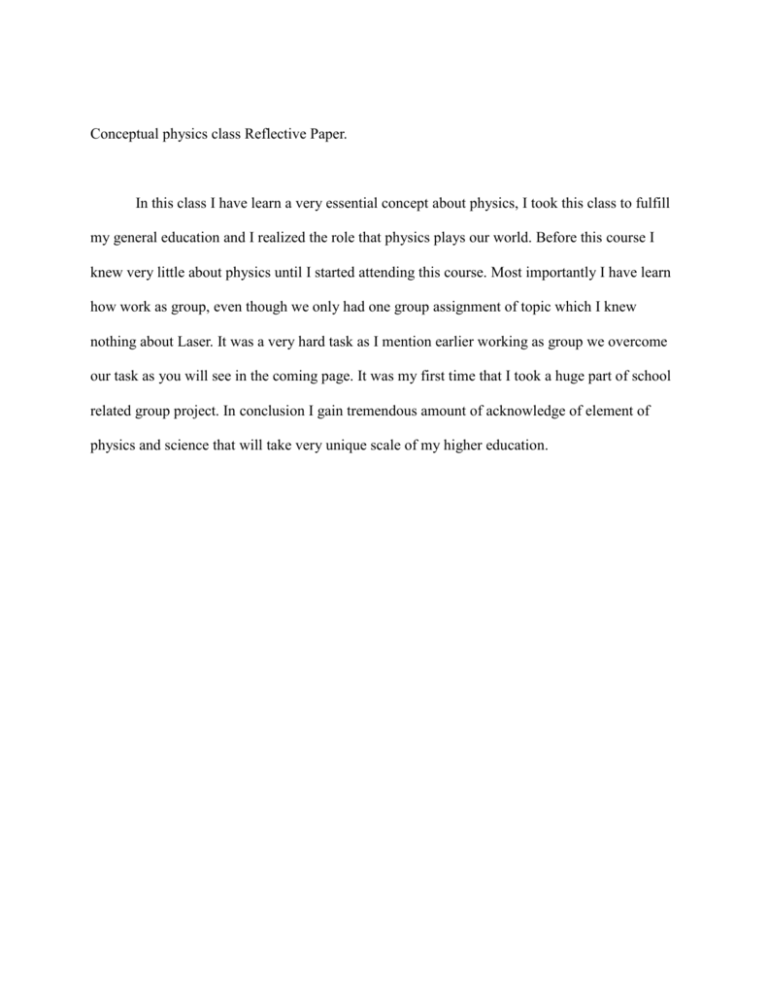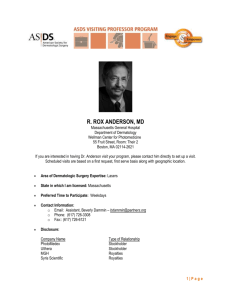File
advertisement

Conceptual physics class Reflective Paper. In this class I have learn a very essential concept about physics, I took this class to fulfill my general education and I realized the role that physics plays our world. Before this course I knew very little about physics until I started attending this course. Most importantly I have learn how work as group, even though we only had one group assignment of topic which I knew nothing about Laser. It was a very hard task as I mention earlier working as group we overcome our task as you will see in the coming page. It was my first time that I took a huge part of school related group project. In conclusion I gain tremendous amount of acknowledge of element of physics and science that will take very unique scale of my higher education. The History of Lasers LASERS The History of Lasers- ePortfolio Hassan M. Sheikh Salt Lake Community College The name LASER is an acronym for Light Amplification by the Stimulated Emission of Radiation. In 1917, Albert Einstein first theorized about the process which makes lasers possible called "Stimulated Emission." Albert Einstein wrote a paper with a new understanding of the structure of light. He argued that light can act as though it consists of discrete, independent particles of energy, in some ways like the particles of a gas. A few years before, Max Planck's work had contained the first suggestion of discreteness in energy, but Einstein went far beyond this. His revolutionary proposal seemed to contradict the universally accepted theory that light consists of smoothly oscillating electromagnetic waves. But Einstein showed that light quanta, as he called the particles of energy, could help to explain phenomena being studied by experimental physicists. For example, he made clear how light ejects electrons from metals. This how he Einstien theory proposed “If tiny but visible particles were suspended in a liquid, he said, the irregular bombardment by the liquid's invisible atoms should cause the suspended particles to carry out a random jittering dance. One should be able to observe this through a microscope, and if the predicted motion were not seen, the whole kinetic theory would be in grave danger. But just such a random dance of microscopic particles had long since been observed.” Before laser there was a “Maser” very close technology but does not use light. In the 1954 Charles town and Author Schawlow invented the Maser as acronyms of (Microwave Amplification by Stimulated Emissions of Radiation) Using ammonia gas and microwave radiation the maser was invented before the (optical) laser. A few year later Charles town and Author Schawlow were granted for maser, their invention was for used as ultraresensitive detector for space research. In 1958 again Charles and Author Schawlow published of paper theories about visible laser, an invention that would use visible spectrum light, however, they did not further their research at the time. Many different materials can be used as lasers. Some, like the ruby laser, emit short pulses of laser light. Others, like helium-neon gas lasers or liquid dye lasers emit a continuous beam of light. In 1960, Theodore Maiman invented the ruby laser considered to be the first successful optical or light laser. Many historian said that Theodore was first person that used the world Laser; however, there is controversy that Gordon Gloud was the first. There is good reason to believe that Gloud was the first that used the world laser. The fact that Gould was a doctoral student at Columbia University under Charles Townes, the inventor of the maser. Gordon Gould was inspired to build his optical laser starting in 1958. He failed to file for a patent his invention until 1959. As a result, Gordon Gould's patent was refused and his technology was exploited by others. It took until 1977 for Gordon Gould to finally win his patent war and receive his first patent for the laser. About the same time that Ruby laser invention and another type of laser was invented by Ali Javan. Ali called his invention Gas Laser ( helium Neon). The gas laser was the first continuous-light laser and the first laser to operate "on the principle of converting electrical energy to a laser light output." By definition, "a gas laser is a laser in which an electric current is discharged through a gas to produce light." Ali Javan received U.S. patent #3,149,290 together with William Bennett for the "Gas Optical Maser". Ali Javan first tested his invention on December 12, 1960. Ali Javan describes the moment in an interview with Betty Blair, "I put in a call to the lab. One of the team members answered and asked me to hold the line for a moment. Then I heard a voice [Mr. Balik], somewhat quivering in transmission, telling me that it was the laser light speaking to me." In 1962, Robert hall discovered the revolutionary type of laser that is still used in many of the electronic appliances and communications systems that we use every day. Semiconductor lasers were small and inexpensive, and are now the most common type of laser. This type of laser is found in all compact disk players and laser printers, laser pointers, supermarket bar-code readers, and most optical fiber communications systems. In 19 Patel began doing fundamental research in laser action in the pure rare gasses. This led him to discover laser action in carbon dioxide (1963). Patel added to this discovery his invention of efficient vibrational energy transfer between molecules, and the combination allowed him to invent the nitrogen carbon dioxide (CO2) laser --- the first gas laser to produce high power radiation continuously (1964). The Idea of laser is being around since 1917 until now. Throughout the course of it history, laser became a breakthrough of technology all over the world. Since then a lot of type laser introduced and even advance and has being improved the revolution of laser, now it is used in many different applications. Principles of Lasers- ePortfolio Chaz C. E. George Salt Lake Community College After research, I've found that lasers are classified as light emitting diodes that use electromagnetic radiation as a form of energy, emitting photons by the process of amplifying the strength of the radiated light. The term “laser” is actually an acronym for “Light Amplification by Stimulated Emission of Radiation.” (“Lasers For Dummies” Retrieved from http://www.wickedlasers.com/laser-tech/dummies.html#1) Lasers come in different forms. Some with visible light and invisible light. This is because of the different frequencies and wavelengths of the light beam. The light or Photon, produced from a laser is actually an electron, moving higher up to a higher-energy orbit, therefore releasing energy in the form of a light particle and going into a very high-energy state. This also applies when the electron moves from the medium, to a relaxed state – High, Medium & Low States are the phases in Electron Movement. These reactions emit energy in the form of a light particle. Hence, causing a light particle to “radiate” from the particles of an atom. In lasers, the term radiation is used because the laser beam (energy) radiates from the surface of the atom. A laser's beam is brought about by the cohesion of light waves, in one wavelength, and direction. Normal light waves (such as those emitting from a lamp) usually have scattered, and incoherent waves; those have different frequencies and wavelengths and even random directions. Coherent light is organized – it is when all light waves are identical in frequency, phase and direction. The coherent light at different intensities is the result of a combination of light waves in phase Lasers are used in many things today, including CD players, tattoo removals, surgery, etc. Different intensities are used depending on the nature of their use. Weschler, Matthew. “How Lasers Work” 01 April 2000. HowStuffWorks.com March 3rd 2011. Retrieved from http://science.howstuffworks.com/laser.htm wrote “The other key to a laser is a pair of mirrors, one at each end of the lasing medium. Photons, with a very specific wavelength and phase, reflect off the mirrors to travel back and forth through the lasing medium. In the process, they stimulate other electrons to make the downward energy jump and can cause the emission of more photons of the same wavelength and phase.” Not all light is retained by these laser mirrors. Some are made so that light waves that are not in correspondence leave the medium, in order to create a system of the purely organized light. As stated before, there are different types of lasers, that have different purposes and reactions; solid, liquid, gas, and semi-conductor. Solid-based lasers, according to www.WiseGeek.com. “What are the Different Types of Lasers” retrieved from http://www.wisegeek.com/what-are-the-different-types-of-lasers.htm, “...solid state lasers were insulator-based, typically using a glass or crystal medium like ruby that was pumped by another non-laser light source to achieve a population inversion...” Liquid-based lasers are “organic dyes are used as active medium inside the glass tube. The complete circulation of dye is done in the tube with the help of a pump. From this organic dye laser light will emerge out.” www.theBigger.com “Explain the Different Types of LASERS?” retrieved from http://www.thebigger.com/physics/principles-ofcommunication/explain-the-different-types-of-lasers/. Gas-based lasers are usually lasers which contain either a mixture of helium and neon, or Carbon Dioxide, that is packed as an active medium. The discharge electrodes at the ends on the lasers is what causes the reaction to occur as explained before, the electrons of the gases react and create photon waves which reflect off of mirrors in a coherent wave. Gas lasers are the strongest types of lasers. Semi-conductor lasers are usually the smaller, low powered lasers. These lasers are usually run by diodes, which direct electricity in only 1 direction. - The flow of electrons in the direction pointed. These lasers are the ones used in CD and DVD players, welding, printing. And relatively “low” power usages. Lasers also come in different classifications. Varying from Class 1 – being the weakest, to Class 4 being the Highest. Class 1 - Laser usually contained within the product and considered non-hazardous. Class 2 & 2A – Visible laser or laser system that cannot cause eye damage unless viewed directly for an extended period of time, or with magnifiers, binoculars, or telescopes. Class 3a & 3b – (a) Laser that Normally does not present a risk of injury if viewed momentarily with an unaided eye, but may present a greater risk if viewed using magnifies, binoculars, or telescopes. (b) Laser can cause eye damage if viewed directly. Class 4 – Laser may cause severe eye injury with short duration exposure to the direct or reflected beam. May also cause sever skin damage and present fire hazard. (“Lasers For Dummies” Retrieved from http://www.wickedlasers.com/lasertech/dummies.html#1) More information on laser classifications can be found at http://www.gkoe.com/products/laser_classes.php Lasers have different variations, being used in simple modern day technology, or medical and industrial research facilities. But its all the same concept. The passing of photon rays from electrons. Lasers are just amplified, organized light, radiated from a source. As the term it comes from states a laser is just simply: Light Amplification by Stimulated Emission of Radiation. Commercial Uses for Lasers LASERS Commercial Uses for Lasers- ePortfolio Andrea L. Goold Salt Lake Community College There are many commercial uses for lasers. Some of the uses are scientific including spectroscopy, lunar laser ranging, material processing, photochemistry, laser cooling, nuclear fusion, and microscopy. There are also military uses including defensive countermeasures, targeting, and firearm sights. As well as medical uses including cosmetic surgery, removing tattoos, scars, stretch marks, sunspots, wrinkles, birthmarks and hair, dermatology, eye surgery and refractive surgery soft tissue surgery, and "no-touch" removal of tumors, especially of the brain and spinal cord. In dentistry they are used for caries removal, endodontic periodontal procedures, tooth whitening, and oral surgery. Some of the most common uses are industrial uses including visual effects, leveling, cutting of metals and other material, welding, marking, guidance systems, surveying, pollution monitoring, barcode readers engraving, laser pointers, and optical communications. This may seem like a long list, but these are just a few of the different ways technology has advanced in the use of lasers. To narrow things down a bit, I will discuss with you one use from each category. Science really pioneered the uses for lasers that have become commonplace in all the other categories of laser use. Scientist use lasers in a variety of ways. In chemistry they use lasers for spectrophotometry, which is the quantitative measurement of the reflection or transmission properties of a material as a function of wavelength. Spectrophotometry deals with visible light, near-ultraviolet light, and near-infrared light. There are two major classes of spectrophotometers: single beam and double beam. A double beam spectrophotometer compares the light intensity between two light paths, one path containing a reference sample and the other the test sample. A single beam spectrophotometer measures the relative light intensity of the beam before and after a test sample is inserted. Although comparison measurements from double beam instruments are easier and more stable, single beam instruments can have a larger dynamic range and are optically simpler and more compact. One of the most familiar uses for lasers in the medical field would be its use in cosmetics. Constantly we hear about laser hair removal, or tattoo removal, or teeth whitening; these all function basically the same way by targeting melanin or pigmentation. Lasers can cause localized damage by selectively heating dark target matter. In the case of hair removal this melanin is in the area that causes hair growth, while not heating the rest of the skin. In removal of tattoos or the whitening of teeth, the laser light is absorbed by dark colors, so laser energy can be absorbed by dark material in the skin or the teeth. The lasers break up the dark area basically annihilating it. The military also uses lasers in a plethora of ways. Most are extremely technical, and some are as common as a laser pointer. One know by most civilians is the laser guidance of missiles and other projectiles. One technique utilizes a laser that is kept pointed at the target, the laser radiation bounces off the target and is scattered in all directions. The missile is then launched or dropped somewhere near the target and when it is close enough for some of the reflected laser energy from the target to reach it, a laser seeker detects which direction this energy is coming from and adjusts the projectile trajectory towards the source. While the projectile is in the general area and the laser is kept aimed at the target, the projectile should be guided accurately to the target. The military can also use this knowledge to build a defense against enemies using this same tactic. Lastly there are the industrial uses for lasers. Cutting is a common use and is most widespread throughout all industry. It is common to see laser cutting in manufacturing and construction alike. Small scale laser cutting machines can be used to cut and shape most types of metals and work in a fairly Laser cutting works by directing the output of a high-power laser, by computer, at the material to be cut. The material then either melts, burns, vaporizes away, or is blown away by a jet of gas, leaving an edge with a high-quality surface finish. The clean finish and high power is what gives lasers an advantage over other cutting techniques.








